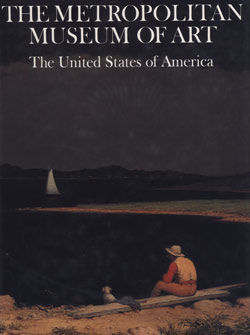Sampler
Rebekah S. Munro American
Rebekah Munro was a student at Mary Balch’s school, the best-known girls’ boarding and day academy in Providence, Rhode Island. Established in 1785, by Sarah Roger Balch (1735-1811) and her daughter, Mary Balch (1762-1831), the school remained active for forty-two years until 1847/8. Mary Balch taught until the 1820s when her step daughter, Elizabeth Walker (ca. 1783-1865), took over, guiding the prestigious school until it closed. Although the Balch’s school is not named in any of the samplers that were made there, many have "Providence," stitched near the maker’s name as seen in the bottom of Rebekah’s sampler. The Balch school educated students between the ages of six and twenty.
Like Rebekah Munro, the earliest students to take classes were born just before, during, and following the American Revolutionary War. While in school they witnessed Providence’s economic growth generated largely from maritime slave trade with the Caribbean and the Atlantic Sea coast, and the opening of American trade with China. They were the first generation of women to grow up in America’s new independent republic at a time when post-Revolutionary women were considered to have an important influence on educating their children to be the future leaders of the new Republic – a role known as "Republican Motherhood."
During the school’s history from 1785 to 1847/48, several chronologically evolving design styles can be traced. The earliest Balch sampler design is found in another Balch sampler in the Met’s collection by Mary Munro (MMA 1984.331.14), Rebekah’s first cousin. Typical of the school’s sampler designs from 1785 to the 1790s, it features blue and white columns framing a central design that includes one of Providence’s well-known buildings, the State House. Rebekah’s sampler is a classic example of a style more commonly found in 1790s. It features a gently meandering floral border and ribbon surrounding richly worked central scenes. At the top there is an identifying motif found on Balch school samplers before 1800—a hanging heart surmounted by a pair of birds, flanked by trumpeting angels. Below that, a fashionably dressed courting couple stands on either side of a fruit tree surrounded by flowers, birds and a small dog. In the bottom scene, shepherds are tending their flock within the tree-filled countryside.
Also included here and in other Balch samplers made before 1802, are stitched maxims, proverbs and sayings taken from published sources. Rebekah’s six-line verse, for example, appeared in the June 4, 1789, edition of Providence’s United States Chronicle’s where the poetry column featured it under the title: "Lines for a young Lady’s Sampler." This verse reiterates the Balch school’s progressive curriculum, admonishing young women to divide their "useful hours" between reading, sewing, and writing. Both cousins, Rebekah and Mary Munro, included in their sampler another commonly used directive relating to the importance of a well-rounded female education: "With Sheba’s queen ye American fair/To adorn your mind bend all your care."
Rebekah Snow Munro left no birth date, age or date of execution on her sampler, but it is believed she was the daughter of Captain James Munro (ca. 1748-1814) and Rebecca Snow Munro (ca. 1757-1817) of Providence. Rebekah’s father was a privateer ship captain and later a partner in Munro, Snow & Munro. Her mother was a descendant of William Snow who immigrated from England to Plymouth, Massachusetts in 1635. Her maternal grandfather, the Reverend Joseph Snow (1743-1793), was a graduate of Rhode Island College (now Brown University), a Captain in the First Rhode Island Continental Infantry and the influential minister of Providence’s Beneficent Congregational Church.
About the same time that Rebekah attended the Balch school, her father, his brother, Benjamin, and her mother’s brother, Samuel Snow, formed an East India trading company, Munro, Snow & Munro. While the Munro brothers remained in Providence, Snow sailed to Canton (now Guangzhou) where he became the second American consul in Canton and built the American hong, the self-contained working and living quarters for Chinese and American traders. As pioneers in the American China trade, Rebekah witnessed Munro, Snow & Munro become one of Rhode Island’s foremost trading firms, and living in her parents’ home she likely was surrounded by Chinese silks and other Chinese goods brought to Providence in her father’s ships. Unfortunately, Rebekah died, unmarried, at the age of twenty-three. Three years later, in 1807, the firm of Munro, Snow & Munro went bankrupt.
Due to rights restrictions, this image cannot be enlarged, viewed at full screen, or downloaded.


